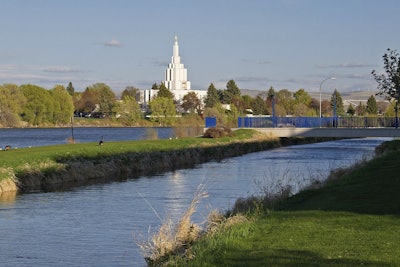
Anthony Peña, government relations manager for the Pacific Northwest Waterways Association (PNWA), said proposals to breach the Columbia and Snake River system’s dams threaten not only grain supply chains in the Pacific Northwest, but the entire U.S. agricultural value chain, at the National Grain and Feed Association’s 128th Annual Convention.
In December 2023, the Biden administration, along with environmental groups, four tribal governments and the states of Washington and Oregon announced a $1 billion plan to address salmon declines in the Columbia and Snake River system.
The plan proposes that the administration provide funding and conduct studies on “how the transportation, irrigation, and recreation services provided by the four Lower Snake River dams could be replaced, to help inform Congress should it consider authorizing dam breach in the future.”
Peña outlined how the economic harm resulting from breaching the Snake River dams would have a ripple effect on a major grain and oilseed export corridor and PNWA’s work on behalf of preserving them.
Snake River’s impact on the region
The Columbia Snake River system spans a vast area the size of France and serves as a crucial transportation and irrigation route for the region. The system comprises a 110-mile stretch from the Columbia River to Portland, Oregon, with an additional 365-mile inland system extending from Portland to Lewiston, Idaho.
Annually, around 55 million tons of cargo traverse the Columbia Snake River system, making it a vital export gateway, particularly for grains and oilseeds destined for East Asia.
Barging is a significant advantage for the Pacific Northwest region, providing a cost-efficient, safe, and reliable mode of transportation for goods. One barge can replace up to 134 semi-trucks, reducing both transportation costs and wear and tear on road infrastructure.
“Take into account, a full barge load usually is four to five barges, so that quantifies to about 600 semi-trucks taken off the road for every full barge tow on the river,” Peña said.
The Snake River dams not only support navigation and transportation, but also play a vital role in irrigation and hydropower. Approximately 67,000 acres of directly irrigated farmland depend on the dams for water supply, ensuring the successful growth of crops in the region. Peña said without these dams, growers would face significant challenges in accessing water for irrigation, potentially leading to a decline in agricultural productivity. The dams also contribute to the generation of hydropower, providing a renewable energy source for the region.
Snake River proposal puts nation’s dams at risk
Potential threats to this vital system began with the release of the Columbia River System Operations Environmental Impact Statement (EIS) in 2020. This comprehensive four-year review process involved collaboration with tribes, states and federal agencies to assess the management of the 14 federal dams in the Columbia River Basin.
The EIS identified a preferred alternative that aimed to preserve the Snake River dams due to their significant benefits in navigation, irrigation and other purposes. Despite the extensive review process and support for dam preservation in the EIS, the federal government faced legal challenges from environmental non-governmental organizations (NGOs) and activist tribes advocating for dam breaching. It prompted the administration to engage in a two-year mediation process with the plaintiffs to avoid prolonged litigation.
During this process, Peña said the administration secretly negotiated with the six sovereign nations, including the states of Oregon and Washington and several treaty tribes. The resulting U.S. government commitments were not shared with industry stakeholders or intervenors, but outlined a pathway for dam breaching and provisions for studying transportation upgrades, recreation, water supply and interim fish operations.
Peña said the Snake River dam proposal has broader implications for the entire country, as Environmental NGOs have made it clear their ultimate goal is the removal of dams across the United States.
“This is not a Pacific Northwest issue,” Peña said. “If this can happen on the Columbia River system, it's going to happen on the Missouri River, on the Mississippi River. The environmental NGOs are set on removing dams in America.”
PNWA leads dam preservation efforts
The PNWA, a 90-year-old trade association, is leading efforts to advocate for the preservation of these dams by resolving conflicting opinions about the dam’s impact on the economy, environment and local communities.
The PNWA’s mission is to support the sustainable development of the Pacific Northwest economy while ensuring environmental stewardship through its membership of 150 organizations, including public ports in Oregon, Washington and Idaho.
Their work encompasses deep draft navigation, inland ports, and small ports, with an emphasis on supporting the funding and policies necessary for the effective operation of the river system. It collaborates with agencies such as the U.S. Army Corps of Engineers and Congress to advance the region’s interests.
Peña said the PNWA will continue to monitor any operational oversteps by the federal government and advocate for accountability and oversight through congressional channels. This includes closely monitoring the annual appropriations process and the biennial Water Resources Development Act (WRDA), which plays a crucial role in authorizing funding for projects related to the dams.
To counteract the prevailing narrative about the Snake River dam’s impact on salmon, the PNWA launched a digital marketing campaign called River Values that aims to highlight the dams’ benefits for navigation, irrigation and the transportation of energy infrastructure projects.
While the proposal’s final outcome is yet to be seen, the Snake River dams’ importance to the grain industry and the potential nationwide consequences of their breaching mean engagement with both Democrat and Republican representatives is crucial to preserving the dams, Peña said.
















